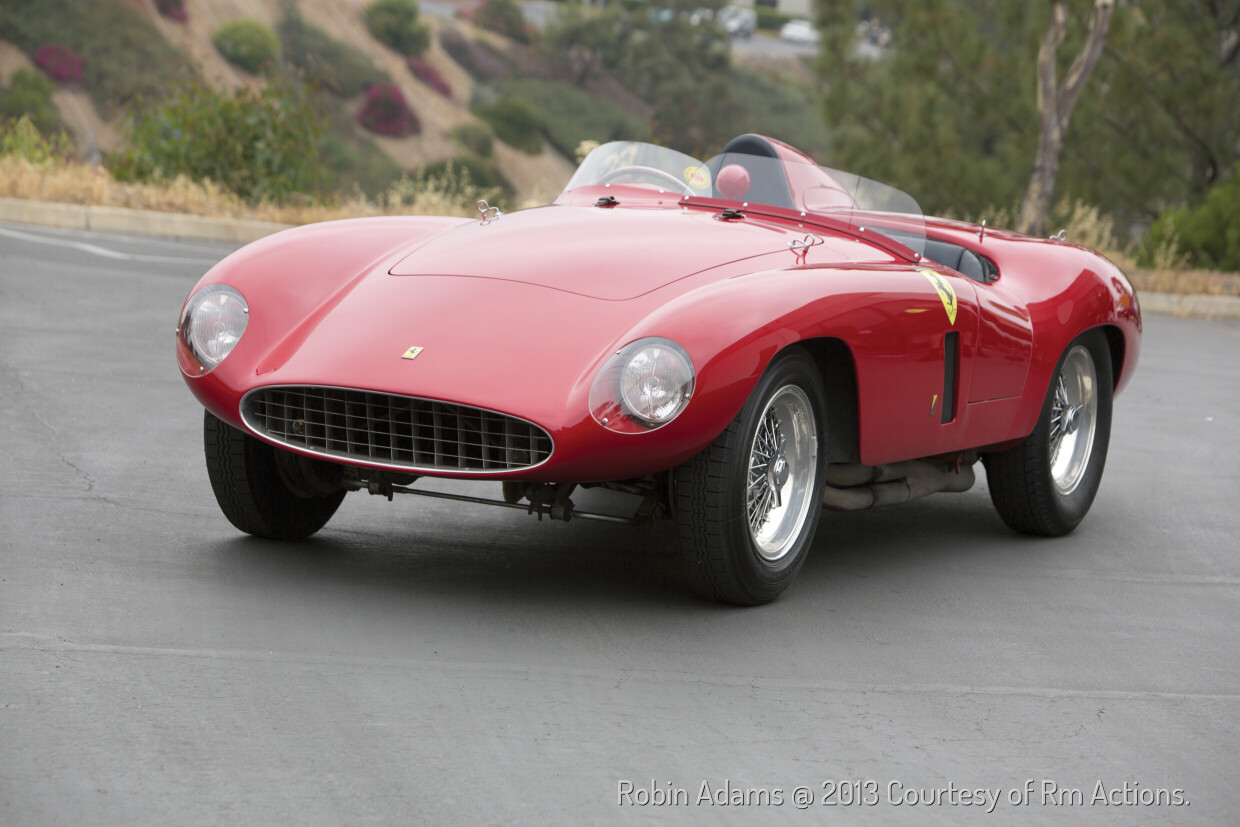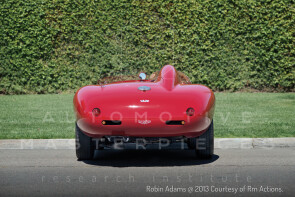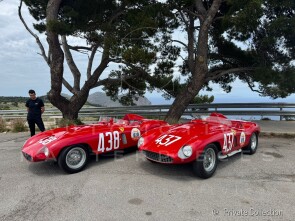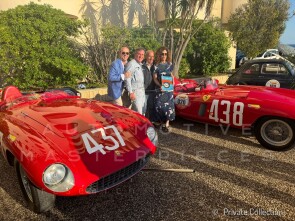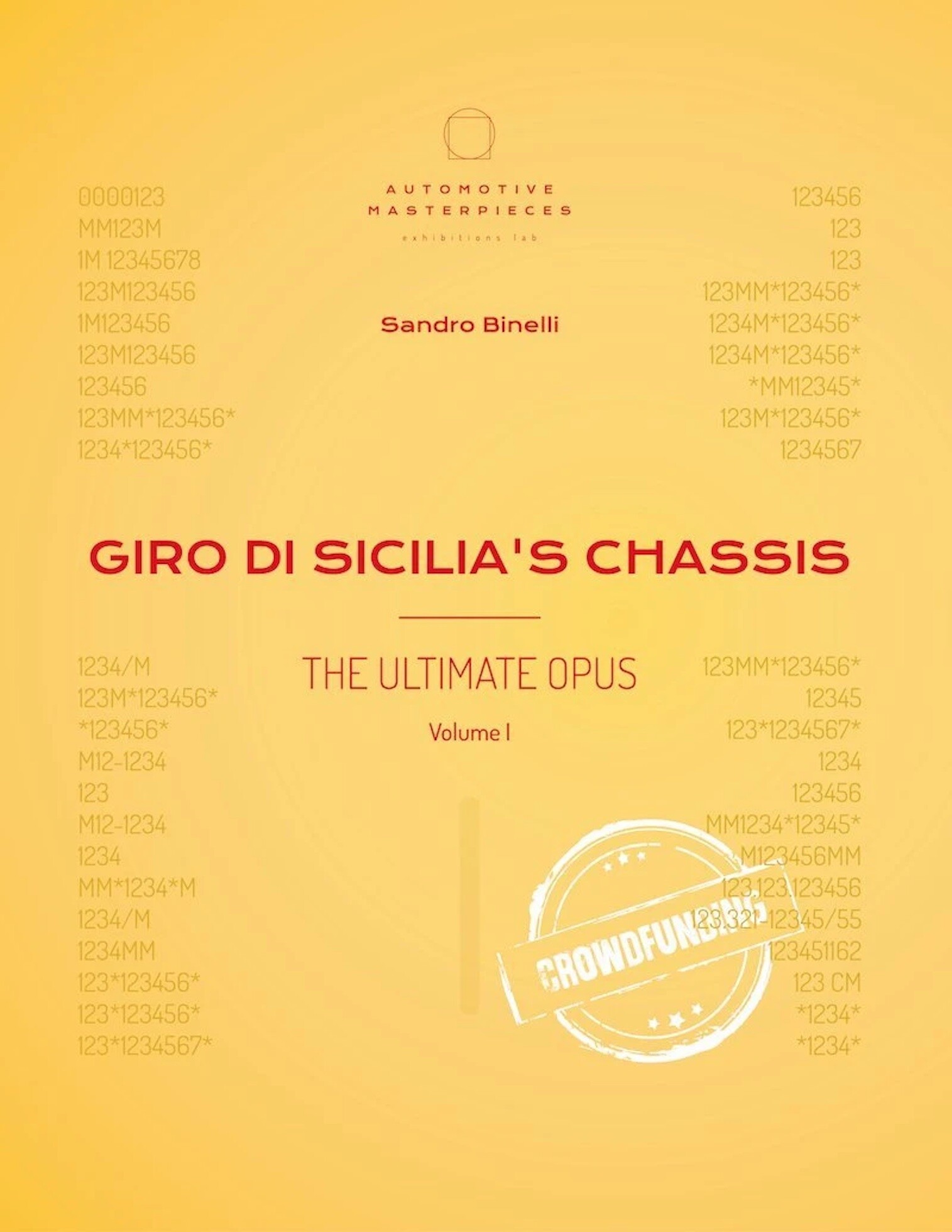
1955 Ferrari 750 monza
ON/OFF
Why am I an Automotive Masterpiece?
L. Limited edition cars
no. 31 manufactured
During the 1950 Formula Two races, Enzo Ferrari observed that four-cylinder race cars from manufacturers like HWM and Cooper exhibited superior fuel efficiency compared to his 12-cylinder cars. The Ferrari V-12 engine, designed by Gioacchino Colombo, had dominated the Formula 2 class in 1949. In 1947, Aurelio Lampredi joined Ferrari and became Colombo's assistant. By the late 1940s, Ferrari tasked Lampredi with developing a four-cylinder engine that was more fuel-efficient and lighter than the larger 12-cylinder unit. When the sport’s governing body decided that the World Championship would be run under Formula 2 regulations, the development of the four-cylinder engine became a high priority. Completely constructed of light alloy, the new engine featured a double overhead camshaft head. Two versions were created: a 2-liter and a 2.5-liter. By 1952, the engine was ready and made its debut in the 500 F2, where Alberto Ascari won the World Championship with six victories out of seven races. He won the title again the following year. In early 1954, Ferrari offered the four-cylinder sports/racer to customers as a two-liter model, with each cylinder displacing almost 500 cubic centimeters. It was named "500 mondial" in honor of Ascari's dominance in the Formula 2 World Championship. The 2-liter four-cylinder engine, equipped with two Weber carburetors, was mounted at the front and drove the rear wheels. Producing 170 horsepower, it propelled the 1,500-pound vehicle to a second-place finish in the 1954 Mille Miglia. A class victory was achieved in 1956 at the 12 Hours of Sebring endurance race.
The Ferrari 750 monza was produced between 1954 and 1955, with approximately 31 examples built. The majority were bodied by Carrozzeria Scaglietti, following a design by Dino Ferrari, Enzo Ferrari's son, while a few early units featured bodies by Pinin Farina. Developed as a successor to the 500 mondial, the 750 monza featured a larger and more powerful engine. It was powered by a 3.0-liter inline-four engine designed by Aurelio Lampredi, delivering approximately 260 horsepower at 6,000 rpm. This engine was an evolution of the earlier 2.0-liter unit used in the 500 mondial, offering increased performance and torque. The car featured a five-speed manual transmission and a lightweight tubular steel chassis, contributing to its competitiveness on the track. The 750 monza made its debut on June 27, 1954, at the Gran Premio Supercortemaggiore held at the Monza Autodrome. In this race, two examples of the model secured the top two positions. Victory went to the pair Umberto Maglioli and Mike Hawthorn, followed closely by José Froilán González and Maurice Trintignant, also in a 750 monza. This remarkable one-two finish at its debut led to the car being named after the Monza circuit. Throughout its racing career, the 750 monza achieved notable results, including a win at the 1954 Tourist Trophy. It was driven by some of the era’s top talents, such as Phil Hill, Eugenio Castellotti, and Alfonso de Portago. However, by 1955, the 750 monza began to face stiff competition from more advanced rivals, including the Mercedes-Benz 300 SLR, prompting Ferrari to develop successors like the 857 S and 860 monza. The Ferrari 750 monza played a significant role in the marque’s motorsport legacy, demonstrating the potential of Lampredi’s four-cylinder engine architecture in larger displacements and further strengthening the partnership between Ferrari and Scaglietti.
The Ferrari 750 monza spider, chassis no. 0530 M (Carrozzeria Scaglietti) was delivered in March 1955 to its first owner, Baron Luigi Chiaramonte Bordonaro Alliata. A member of one of the oldest noble families in Sicily, he was a skilled gentleman driver, often behind the wheel of official or semi-official Ferrari cars, and a leading figure in Southern Italy’s motor racing scene during the 1950s. In April of the same year, the baron entered the car in the Giro di Sicilia, where he achieved an excellent result: 19th overall and 6th in class. This was followed by a series of brilliant performances, especially on home soil: 1st overall in the Palermo–Monte Pellegrino and in the Messina–Colle San Rizzo, 2nd overall in the Trapani–Monte Erice, and 3rd overall in the Catania–Etna. He also finished 20th overall and 2nd in class at the Circuito del Mugello. His participation in the Targa Florio, however, was less fortunate: although entered, he did not start the race. The 1956 season brought mixed results: Chiaramonte Bordonaro again won the Palermo–Monte Pellegrino and took 2nd overall at the Grand Prix of Tunis. Yet once again, the Targa Florio proved unfavorable: although he started, he did not finish the race. In 1957, the baron sold the car to Bernardo Cammarota. The car continued to race and returned to the Targa Florio under the banner of Scuderia Partenopea, driven by Domenico Tramontana and Giuseppe Alotta. Once again, however, the Sicilian race was unforgiving: the 750 Monza was forced to retire on the seventh lap. In 1962, the car was acquired by well-known collector Carlo Leto di Priolo, who displayed it for about ten years at the Monza Autodrome Museum. Like most of Leto di Priolo’s cars, the 0530 M was sold at the Sotheby’s auction held in Monza in June 1972. Subsequently, the car changed hands among several collectors and left Italy, passing through the United Kingdom, the Netherlands, and Spain. In 1978, it took part in the Zandvoort International, finishing 7th overall, thus beginning a new career in major historic motoring events. It already appeared at the Mille Miglia in 1982 and at the historic Targa Florio in 1986. In the following years, it changed owners again and was entered in numerous concours d’elegance. In 2000, the car returned to Italy, where it was re-registered. Between 2001 and 2010, it took part in ten consecutive editions of the Mille Miglia retrospective and was featured in numerous books devoted to historic cars and vintage racing. In August 2013, it was auctioned by RM in Monterey and sold for a significant sum to a private collector. In 2025, the car took part in the commemorative edition of the Giro di Sicilia, driven by Luigi Bordonaro di Chiaramonte, heir of the first owner. On that occasion, an informal tribute was held at the historic Villa Chiaramonte Bordonaro in Colli.
